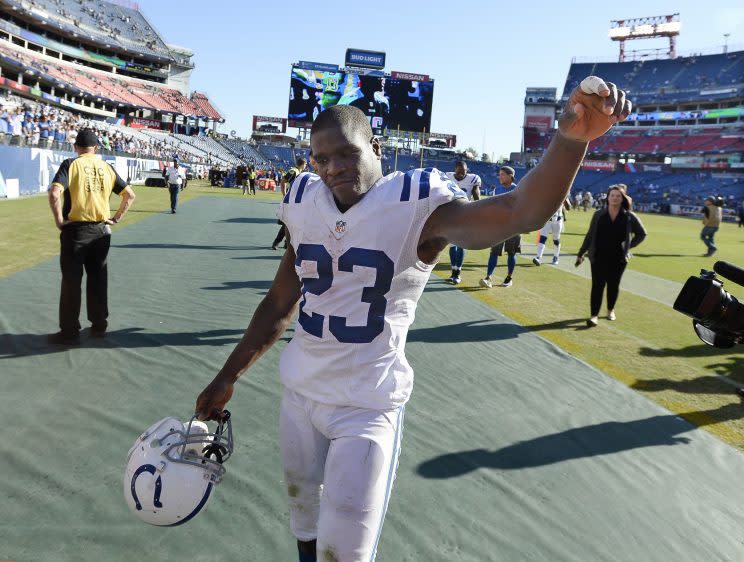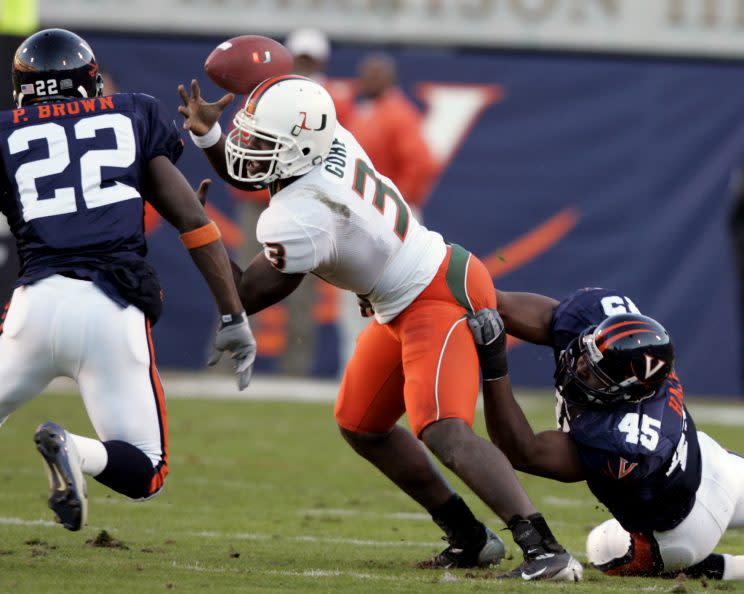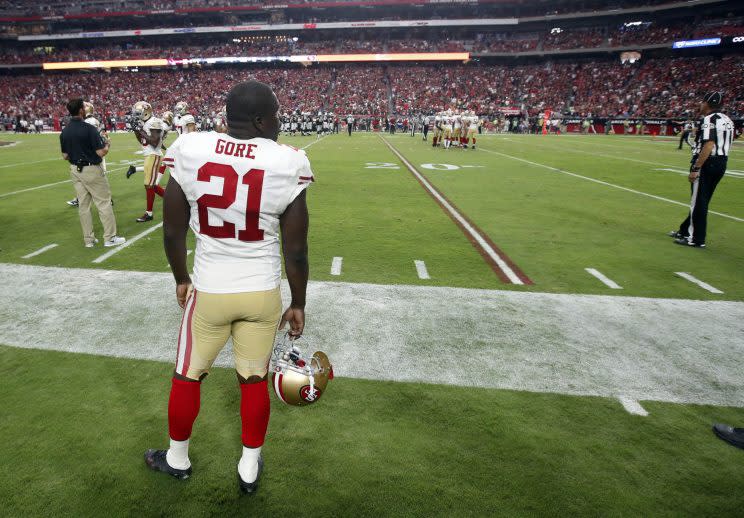Frank Gore is legendary without a legend
Four point four.
It doesn’t sound like much for an NFL running back, but as one of Frank Gore’s oldest football friends says, “He doesn’t look like much.”
That much may be true. When it comes to Frank Gore, there isn’t a ready image of him pulverizing defenders like Marshawn Lynch or leaping over would-be tacklers like Earl Campbell or breaking ankles like Barry Sanders.

What there is, though, is that 4.4 yards-per-carry average – which is more than LaDainian Tomlinson averaged, more than Curtis Martin, more than Emmitt Smith, and the same as Walter Payton carried over his legendary career. Four-point-four has led Gore to an exalted place: ninth on the NFL’s all-time rushing list heading into Thursday’s game against Pittsburgh with 12,682 yards, just ahead of Jim Brown, and on the cusp of passing Tony Dorsett (12,739) for eighth.
How did Gore, dubbed by Sports Illustrated as the “most overrated” running back in the 2005 draft, make this happen? How has he, the sixth back taken in that draft, thrived while the other five running backs taken before him – Ronnie Brown, Cedric Benson, Cadillac Williams, J.J. Arrington and Eric Shelton – washed out years ago?
“I don’t see Frank as a ‘wow’ running back,” explains Brett Romberg, one of his teammates at the University of Miami. “I see him as a pain in the ass for 60 minutes.”
In an era when the running back position has been seriously downplayed, where fantasy stats overshadow real ones, Frank Gore plunked himself among the all-time greats. The 33-year-old is legendary without a legend. And although 4.4 doesn’t sound like a long way, Frank Gore traveled quite a distance to get there.
**********
When Jonathan Vilma arrived at the University of Miami in 2000, the backfield included Clinton Portis, Najeh Davenport and Jarrett Payton. Willis McGahee was on the way.
Still, Vilma raved about how his high school teammate would pummel his way into the Hurricanes’ rotation when he arrived the following season.
“No way,” his teammates would say.
“Sure enough, we get into training camp, and [Frank] was just too good for the freshmen,” Vilma recalls. “After the first freshman scrimmage, they bumped him up.”
Still, there was a line in front of him to get on the field. Then running backs coach Don Soldinger told Gore that the way to do that was to learn pass protection. That usually humbled the big talkers. Then Soldinger’s phone rang at 3:30 one morning. It was Gore.
“What’s the deal, bro?” the coach rasped.
“I learned all the pass protections,” Gore said. “Quiz me.”

That freshman year, Gore finished second on the team (to Portis) in rushing yards and touchdowns for a national championship squad many consider one of the best in college football history.
With Portis off to the NFL, the starting job was to be Gore’s entering his sophomore season, until he tore an ACL in spring practice. He rehabbed, regained the starting job the next year and was on his way to a breakout season when he tore his other ACL in the fifth game of the season.
“I ain’t playing no more,” he told Soldinger.
But there was something that drove him on.
From the time Gore was just a kid, his mother, Lizzie, was on kidney dialysis. She also battled drug use. Gore carried a sense of responsibility and a sense of pride in his work. He got that not only from his mom, but from taking care of her.
“When someone goes through something like that, to have the personality and drive on Saturdays and Sundays,” says former teammate Chris Myers, “it’s amazing to me.”
Gore returned in 2004, started every game and, finally healthy, led the Hurricanes in rushing.
**********
When it comes to Frank Gore, there’s no tell.
“He has that look, that heavy brow,” says Romberg. “Never know if he’s really interested or he’d like to be elsewhere.”
In fact, Gore didn’t want to talk about himself for this story, not even for a minute.
Not about how he made it back on the field after two ACL repairs, or about how he’s disproven the draftniks who didn’t give him much of a chance coming out of Miami in 2005 as a third-round pick by the San Francisco 49ers.
“There are probably eight to ten rookie runners that could have given [Kevan] Barlow a real run for his money in training camp,” one fantasy expert wrote, “but Gore isn’t one of them.”
And so the cycle repeated for Gore in San Francisco.
He toiled on and off the field in that stealth way of his. One night, then-coach Mike Nolan found Gore at the Niners’ training facility after 10 p.m. The running back explained he returned to work because he had nothing else to do.
After his rookie season, Gore had two shoulder surgeries. Running backs need two healthy shoulders and two healthy legs. Gore had undergone surgery on all four parts by age 23.
“He’s so innately driven to compete against some unknown adversary,” says former Miami offensive lineman Joel Rodriguez, who is among Gore’s closest friends. “Whatever it is, he’ll do it. He’s such a mentally tough, driven, competitive person.”
Rodriguez laughs when he thinks of Gore returning to Miami in the boiling hot summer, walking around in shorts and a long-sleeve black thermal shirt. Gore’s Instagram serves as proof, with video of him bench-pressing in a black long-sleeved shirt, dragging a weighted sled in a black long-sleeved shirt, boxing in a black long-sleeved shirt.
“If he’s not sweating profusely, he’s not working,” Rodriguez says. “Even if someone else is doing the same workout, he’s wearing the thermal shirt and it makes him better.”
Gore started one game his rookie season with the Niners, earned the starting job in 2006 and started every game he was healthy for but one over the next nine 49er seasons, including one in 2007 against the St. Louis Rams that happened four days after his mother died. Gore rushed for two touchdowns in a 17-16 49ers’ victory.
**********
Frank Gore called Vilma in 2011. For the first time since Gore arrived in San Francisco, the 49ers were winning. It looked like they might face the New Orleans Saints in the playoffs, though it was only about halfway through the season.
In his six seasons with the 49ers, Gore had rushed for more than 6,400 yards. But the Niners had never finished a season better than 8-8, which helped explain how the yardage Gore was racking up had barely registered east of San Francisco Bay.
“He calls me up,” Vilma recalls, “and he’s like, ‘I didn’t know what this feels like! This feels so good! We’re going to beat you, I can’t wait!’ I told him, ‘Simmer down man. We got six games to play.’

“That feeling he had, I’ll never forget what he sounded like.”
Six seasons in, a couple Pro Bowl selections, four 1,000-yard seasons, but all Gored wanted was to win – he wanted the ring. He still wants it.
“He’s the same,” says Soldinger. “He still calls me. Calls all the time. The biggest thing was he never won the Super Bowl. He gets frustrated because guys are collecting checks.”
There is no playing out the string for Gore. Now in his 12th season, the last two with the Indianapolis Colts, Gore is still grinding. He’s on his way to another 1,000-yard season – which would be his ninth. In fact, only once in his career has Gore played all 16 games and not rushed for at least 1,000 yards – the 2015 season when he logged 967. Still, winning, not yards, is the focus.
“I didn’t come here for this,” he said after the Colts got off to a 2-4 start this season. “I came here to get into the tournament.”
The Colts are 3-1 since and in position to get into “the tournament.” With Andrew Luck in the concussion protocol, they’ll lean on Gore now more than ever.
**********
There are almost too many NFL players from that Miami era to count, from Portis to Vilma to Vince Wilfork to Ed Reed to Andre Johnson. Many had strong careers. Almost all of them are out of the game now, 15 years later, working in the real world or coaching or commentating on TV. Probably none of them could have picked the one player who excelled for the longest.
In 12 NFL seasons, Frank Gore, the man who entered the league a question mark because of his durability, has missed significant time because of injury just once, in 2010, when he fractured a hip late in the season. He hasn’t missed a game since.
“He was meant to play the game,” Myers says. “The game fully appreciated him and they took care of each other.”
It’s 2016, and still it’s Frank Gore, 4.4.
More NFL on Yahoo Sports

